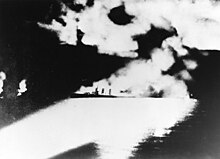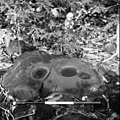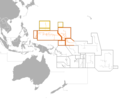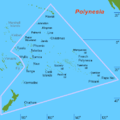Portal:Oceania
The Oceania PortalOceania (UK: /ˌoʊsiˈɑːniə, ˌoʊʃi-, -ˈeɪn-/ OH-s(h)ee-AH-nee-ə, -AY-, US: /ˌoʊʃiˈæniə, -ˈɑːn-/ ⓘ OH-shee-A(H)N-ee-ə) is a geographical region comprising Australasia, Melanesia, Micronesia, and Polynesia. Spanning the Eastern and Western Hemispheres, at the centre of the water hemisphere, Oceania is estimated to have a land area of about 9,000,000 square kilometres (3,500,000 sq mi) and a population of around 44.4 million as of 2022. When compared to the continents (which it is often compared to, not including Australia), Oceania is the smallest in land area and the second-least populated after Antarctica. Oceania has a diverse mix of economies from the highly developed and globally competitive financial markets of Australia, French Polynesia, Hawaii, New Caledonia, and New Zealand, which rank high in quality of life and Human Development Index, to the much less developed economies of Kiribati, Papua New Guinea, Tuvalu, Vanuatu, and Western New Guinea, while also including medium-sized economies of Pacific islands such as Fiji, Palau, and Tonga. The largest and most populous country in Oceania is Australia, and the largest city is Sydney. Puncak Jaya in Highland Papua, Indonesia, is the highest peak in Oceania at 4,884 m (16,024 ft). The arrival of European settlers in subsequent centuries resulted in a significant alteration in the social and political landscape of Oceania. The Pacific theatre saw major action during the First World War with the Japanese occupying many German territories. During the Second World War, Allied powers the United States, Philippines (a U.S. Commonwealth at the time) and Australia fought against Axis power Japan across various locations in Oceania. (Full article...) Selected geographic article -Hunter Island and Matthew Island are two small and uninhabited volcanic islands in the South Pacific, located 300 kilometres (190 mi) east of New Caledonia and south-east of Vanuatu archipelago. Hunter Island and Matthew Island, 70 km (43 mi) apart, are claimed by Vanuatu as part of Tafea Province, and considered by the people of Aneityum part of their custom ownership, and were claimed by France as part of New Caledonia. Small, arid, without fresh water and not easily accessible, the islands had no interest for Britain or France during their colonisation of the Pacific in the course of the 18th and 19th centuries. France officially annexed both islands in 1929. In 1965, the United Kingdom also claimed the two islands, as part of the New Hebrides. France conducted a symbolic occupation in 1975. In 1980, on its independence, Vanuatu claimed sovereignty, but made no occupation of the islands. In 1979, Météo-France set up an automatic weather station on one of the islands, and the French Navy regularly visits both of them. (Full article...)Related portalsSelected article -The Battle of Savo Island, also known as the First Battle of Savo Island and in Japanese sources as the First Battle of the Solomon Sea (第一次ソロモン海戦, Dai-ichi-ji Soromon Kaisen), and colloquially among Allied Guadalcanal veterans as the Battle of the Five Sitting Ducks, was a naval battle of the Solomon Islands campaign of the Pacific War of World War II between the Imperial Japanese Navy and Allied naval forces. The battle took place on 8–9 August 1942 and was the first major naval engagement of the Guadalcanal campaign and the first of several naval battles in the straits later named Ironbottom Sound, near the island of Guadalcanal. The Imperial Japanese Navy, in response to Allied amphibious landings in the eastern Solomon Islands, mobilized a task force of seven cruisers and one destroyer under the command of Vice Admiral Gunichi Mikawa. The task forces sailed from Japanese bases in New Britain and New Ireland down New Georgia Sound (also known as "The Slot") with the intention of interrupting the Allied landings by attacking the supporting amphibious fleet and its screening force. The Allied screen consisted of eight cruisers and fifteen destroyers under Rear Admiral Victor Crutchley, but only five cruisers and seven destroyers were involved in the battle. In a night action, Mikawa thoroughly surprised and routed the Allied force, sinking one Australian and three American cruisers, while suffering only light damage in return. Rear Admiral Samuel J. Cox, director of the Naval History and Heritage Command, considers this battle and the Battle of Tassafaronga to be two of the worst defeats in U.S. naval history, with only the attack on Pearl Harbor being worse. (Full article...)Did you know -
General images -The following are images from various Oceania-related articles on Wikipedia.
TopicsSubcategoriesThings you can doAssociated WikimediaThe following Wikimedia Foundation sister projects provide more on this subject:
In other languagesWikipedia in other languages used in Oceania:
More portals |









































































